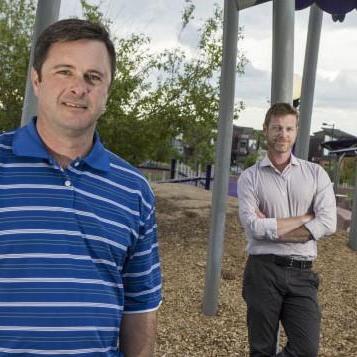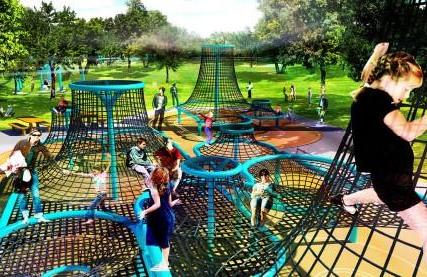
By serving Coloradans who have less power, privilege and income, and by prioritizing Coloradans of color, we keep equity at the heart of our work to bring health in reach.

EDITOR'S NOTE: A spongy, forgiving walking path for ramblers of all generations. Fountains to run through. A kiosk to check out Frisbee golf discs. Outdoor cooking classes demonstrating tasty uses of zucchini from the public garden. All these and more were the ambitious goals of City Loop, an innovative playground redesign at Denver’s vital City Park. But in the spring, the city announced City Loop was dead, at least at City Park, because of community opposition. We sat down with two of the main designers of City Loop to talk about what went wrong, what was still right about the idea and whether its cutting-edge approach to fitness and public space could be revived elsewhere.Following is an edited conversation with Gordon Robertson, director of planning at Denver Parks and Recreation, and Michael Bouchard, senior landscape architect and manager of the City Loop project.
We did a playground master plan – the only one I know of nationwide – that looked at how to do playgrounds in a different way, so it wasn't all steps and platforms and slides. Get people moving in new ways and get all generations moving. As City Park’s Dustin Redd playground was aging past its lifetime [about 20 years], we thought, what a great place to implement this new way of doing play and getting all generations interested in active living.
A lot of cities that invested 100 years ago in the Olmsted model of parks now have new generations of folks with younger families moving in looking for new ways to utilize these park spaces. A long time ago when they were built, the open meadow was a way for people in petticoats to drive around in carriages and admire the open view.
This is a regional park, even though people don’t like us to say that. To them, it’s their neighborhood park. But it needs a regional playground. So we scale it a big playground, appropriate for the size of the park. The existing Dustin Redd is 1 acre, and it was already vastly undersized for the population it was intended to serve. So the initial redesign was a regional playground at 3 acres. We did later split the difference after getting feedback and go to 2 acres of impact.
The neighborhood park playground is 1 acre and typically budgeted at $250,000; the next size up in a larger park is 2 acres at $400,000 to $600,000, and a 3-acre regional playground is over $1 million. And this was going to be above that regional standard.
We have 500 acres at City Park, and 150 acres of it is still in passive meadow green space. The project site is in a meadow that’s 14 acres of that 150 acres, and within that 14 acres the impact is about an acre with Dustin Redd. So we developed this 3-acre play design, which is spread out, but it’s 3 acres of impact – not what you might have heard that it impacts the whole 14-acre meadow.
The biggest thing, frankly, is the distributive play around the loop. The loop was envisioned as a rubberized walking track much as you’d see in a high school athletic track; there is no access to those in [Denver Public Schools] because they are locked behind fences, and we don’t have any in the park system. Older folks love to walk on them and run on them; they are very gentle on the knees. It was going to attract older groups and moms groups that come in the morning to exercise, very intergenerational. The plaza space was a unique feature – a kiosk with play blocks packed inside that people could pull out and play with. It would have kites, hammocks, Frisbees, soccer balls, take a book/leave a book, and it would have a college student making $9 an hour hanging out there at the busy times of the day to check out equipment. It was going to be a very social gathering area. And the path leads you from one thing to the next.
Here’s one lesson learned: Our consultants were terrific, and they really pushed the edge on these graphics they created. And while that works for someone like me who appreciates that kind of excitement and graphic detail, I think for people who ended up hating this project, it’s exactly what they didn’t want to see: super bright, super colorful. If we did it again, we’d use watercolors.
People really honed in on the blue of the tubing, yellows and oranges and blues. If you saw it in a real landscape at a real scale, it wouldn’t look anywhere as vibrant and crazy as that.
Disney, Elitch’s, we heard a couple of different references.
We were supposed to receive our 60 percent design, and frankly, already we had told the architects it was too much and we needed to scale back some of the built design. Unfortunately the 60 percent design got out, and people got hold of it and said, “You can’t do this in our park.”
We appreciated people’s input, and we had 80 people show up at one meeting but they were almost all from one age group and demographic. They all had the exact same opinion; much of what they said I couldn’t disagree with, and they were things we were already doing. I think there was middle ground we could have achieved.
There was such coordinated opposition from a segment of folks. While we know there is as great, or frankly, greater support from people who wanted us to pursue it, they were not as vocal and as coordinated. What they will tell you is they have lives and young kids and very demanding jobs, and while they’d love to come to meetings on weekends and coordinate an Internet campaign, they just didn’t have time. It’s definitely a bit of a struggle. The mayor’s office was receiving letters daily, we were receiving letters daily … and in a meeting of 200 people, where 10 of them were supportive of finding common ground, the majority wouldn’t even give us the common courtesy of listening. There are 200 people who hate it, clearly; there are how many thousands of people living near the park? The demographics show that those 200 do not represent the people living around the park.
We have said we are looking at the west side of the city. We’ve heard that sentiment from Paul and we know there are underserved communities in that area. We went through a lot of work to get this design, and we owe it to the city to move forward somewhere if we can.

Definitely not a loss. What we've accomplished is fantastic and we knew we had a longer way to go. A lot of people are struggling with public process right now. People don’t like to come to meetings – unless there’s a crisis. If we called a meeting about trash in Washington Park, nobody would show up. If we called a meeting about the trash that’s a result of alcohol use in parks and talk about banning alcohol, that’s a crisis and people show up. There were 50 different touch points where City Loop was on display and many times, no one showed up.
City Park is a collection of problems: the zoo, the museum, the events. Parking is an issue on a handful of days only; 94 percent of the time you can drive in and there’s only one guy sitting in his car reading the newspaper. This plan was to get people to come to the park at all different times of the day and the week.
We’ll be repairing Dustin Redd playground to the best of our ability and hope to keep it going for two or three or four years until the dust settles and we can return to planning. We need to find better ways to communicate the problem we’re trying to solve – ways of activating the other side of the debate, not just one group of opponents.
When you mention to some City Park neighbors that the Denver crown jewel has whole green sections that are largely empty most of the day, they have a sarcastic but effective response:
“And the problem with that is?”
Tom Morris, a retired architect, was among those at South City Park Neighborhood Association who vehemently opposed the City Loop “activation” area with responses like that one.
The “Disney-fication” proposed by a new generation of parks planners tries to solve a problem that doesn’t exist, and creates new problems in the bargain, Morris argued. City Park is already busy with the zoo, an enormous museum and other visitors. Quiet green space offering leisurely strolling or picnics – without crowds – is also a primary function of city land.
“The Loop was not in keeping with the historical character of City Park,” Morris said. “The people in charge did no evaluation of what effect another regional attraction would have on the park. No parking study, no maintenance plans, no traffic studies.”
As for Loop proponents’ claims that a project beneficial to multiple generations and tens of thousands of neighbors was killed by a few dozen cranky old folks, Morris made no apologies. A similarly vocal group had stopped past egregious City Park land grabs such as a fire station and an aquarium, he noted.
“The coalition opposing the Loop was started by older people who had experience defending the park from thoughtless intrusions. The recognition that changes have effects are apparently lost on the millennials who believe more is always more,” he said.
This article was originally published in the Summer 2014 issue of Health Elevations.